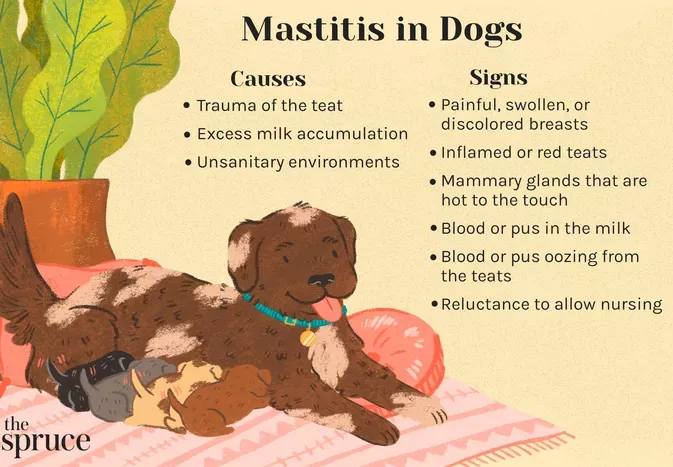Mastitis in Dogs
Updated on 04/26/24

Mastitis in Dogs: A Detailed Guide to Prevention, Treatment, and Management
Introduction
Mastitis, a condition characterized by inflammation of the mammary glands, can affect both lactating and non-lactating dogs. This painful and potentially life-threatening condition requires prompt attention and proper management to ensure the health and well-being of the affected dog. In this comprehensive guide, we delve into the causes, symptoms, diagnosis, treatment options, and preventive measures for mastitis in dogs, providing valuable information to help pet owners understand and address this condition effectively.
Causes of Mastitis in Dogs
Mastitis can arise from various factors, including:
1. Bacterial Infections: The most common cause of mastitis is bacterial infection, with Staphylococcus, Streptococcus, and Escherichia coli being常见的病原体。感染可能通过伤口、乳头裂缝或乳汁淤积进入乳腺。
2. Fungal Infections: Less commonly, fungal infections, such as Candida, can cause mastitis. These infections typically occur in dogs with compromised immune systems or underlying health conditions.
3. Trauma: Physical trauma to the mammary glands, such as bites, scratches, or blunt force, can lead to mastitis by damaging the tissue and creating an entry point for bacteria.
4. Hormonal Imbalances: In non-lactating dogs, hormonal imbalances, especially elevated levels of progestin, can stimulate milk production and increase the risk of mastitis.
Symptoms of Mastitis in Dogs
Recognizing the symptoms of mastitis is crucial for timely diagnosis and treatment. Common signs include:
1. Swollen and Painful Mammary Glands: Affected mammary glands appear enlarged, hard, and warm to the touch, indicating inflammation and swelling.
2. Redness and Heat: The skin over the affected mammary glands may become red and feel warm to the touch due to increased blood flow and inflammation.
3. Discharge from Mammary Glands: Dogs with mastitis may exhibit a discharge from the affected mammary glands, which can range from milky to purulent (containing pus) depending on the severity of the infection.
4. Fever and Lethargy: Systemic infections can cause fever and lethargy in affected dogs.
5. Loss of Appetite and Nursing Problems: Lactating dogs with mastitis may experience decreased milk production and difficulty nursing due to pain and discomfort.
Diagnosis of Mastitis in Dogs
Proper diagnosis of mastitis involves a thorough physical examination and evaluation of clinical signs. Additional diagnostic tests may include:
1. Cytology: A sample of fluid from the affected mammary glands is examined under a microscope to identify any bacteria, white blood cells, or other abnormalities.
2. Bacterial Culture: A sample of the discharge from the mammary glands is cultured to identify the specific bacteria causing the infection and determine appropriate antibiotic treatment.
3. Imaging Tests: In some cases, X-rays or ultrasound may be used to assess the extent of infection and rule out underlying medical conditions.
Treatment Options for Mastitis in Dogs
The treatment of mastitis depends on the severity of the infection and the underlying cause. Common treatment options include:
1. Antibiotics: Antibiotics are the primary treatment for bacterial mastitis. The choice of antibiotic is based on the results of the bacterial culture.
2. Anti-Inflammatory Medications: Non-steroidal anti-inflammatory drugs (NSAIDs) or corticosteroids can help reduce inflammation and pain.
3. Warm Compresses and Massage: Applying warm compresses to the affected mammary glands and gently massaging the area can promote circulation and assist in the drainage of infected fluid.
4. Surgery: In severe cases, surgery may be necessary to remove severely infected mammary glands or drain abscesses.
Preventive Measures for Mastitis in Dogs
Preventing mastitis in dogs is essential to maintain their health and well-being. Effective preventive measures include:
1. Proper Hygiene: Maintaining a clean environment for the dog and her puppies helps reduce the risk of bacterial infections.
2. Monitoring and Proper Nursing Practices: Lactating dogs should be closely monitored to ensure puppies are nursing effectively and that the mammary glands are draining properly.
3. Avoiding Overfeeding and Obesity: Overfeeding and obesity can contribute to hormonal imbalances that increase the risk of mastitis in non-lactating dogs.
4. Regular Veterinary Check-ups: Regularly scheduled veterinary check-ups allow for early detection and treatment of underlying health conditions that may increase the risk of mastitis.
Conclusion
Mastitis in dogs is a serious condition that requires prompt and proper management to ensure the health and well-being of the affected dog. By understanding the causes, symptoms, diagnosis, treatment options, and preventive measures, pet owners can effectively address this condition and minimize the risk of complications or recurrence. Seeking professional veterinary advice and following the recommended treatment plan are essential for a successful outcome and the long-term health of the dog.
Explore More Pets

Basic Training
Puppy and Baby Introductions

Working Dog Breeds
All About Search and Rescue Dogs

Dog Treatments
Puppy Vaginitis: Signs, Causes and Treatment

Dog Adoption
After More Than 1,200 Days in the Shelter, Coco Goes Home

Basic Training
How to Train Your Puppy to Go on Potty Pads

Hybrid Dog Breeds
The Difference Between a Mutt, Mixed Breed, or Designer Dog?

Dog Treatments
Nail Problems in Dogs

Puppies
7 Reasons Why Two Dogs Are Better Than One